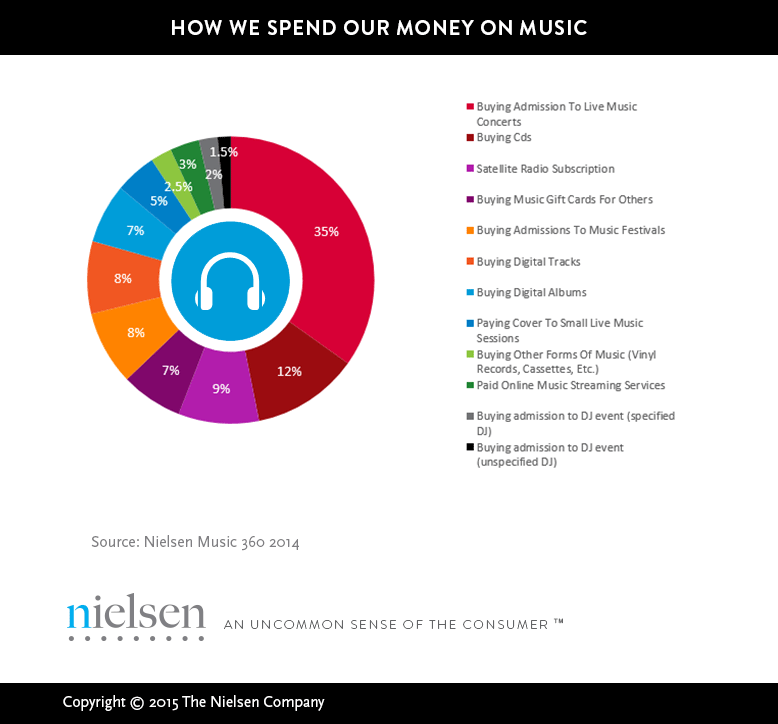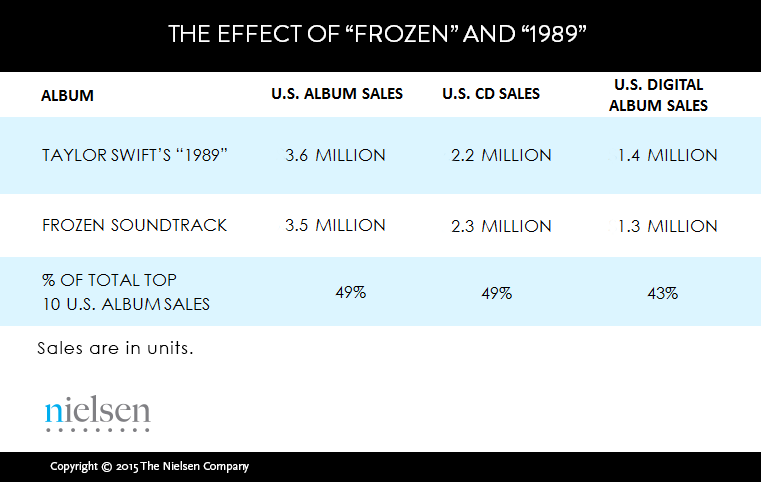Music consumption has changed, but consumers’ appetite for music is as strong as ever.
According to Nielsen’s Music 360 2014 study, 93% of the U.S. population listens to music, spending more than 25 hours each week jamming out to their favorite tunes. In fact, 75% of Americans say they actively choose to listen to music, which is more than they claim to actively choose to watch TV (73%). Whether in the car (25%), at work (15%) or while doing chores (15%), we spend big chunks of our time listening to music. The difference from times past, however, is that the way we individually tune is as unique as the ear buds or headphones we sport while listening.
And when it comes to how we’re listening, the story is largely a digital one. Americans streamed 164 billion on-demand tracks across audio and video platforms in 2014, up from 106 billion in 2013. Not only did the number of streams in 2014 surge past the number a year earlier, but the pace of weekly streams hit new heights. For example, the week ending Nov. 9, 2014, marked the first time that total streams for one week surpassed 4 billion. Of those, 3.9 billion were on-demand audio and video streams (1.845 billion audio, 2.05 billion video). In any given week across America, 67% of music fans tap into the growing pipeline of streaming music to get their feet moving or just tune out the rest of the world.
While 2014 was a monumental year for music streaming, it highlighted how the music landscape is fragmenting, just like the entire media arena is. CDs and cassettes declined, while vinyl reported its ninth consecutive year of sales growth. With 9.2 million units sold in 2014, vinyl sales roared past the 6.1 million units sold in 2013 by nearly 52%. Given the more-than-two-year trend of rising sales, vinyl now accounts for 6% of physical album sales.
On average, U.S. consumers report spending $109 each year on music. So aside from albums, what other types of music options are consumers spending their money on? Surprisingly, live events are gaining momentum, as they now account for more than half of total music activity spending each year.

But despite the ramp up in events and festivals, albums and songs themselves remain the heart of any true discussion about music. Overall, 2014 was a bifurcated year for physical music sales. While physical album sales were down overall, there were some bright spots as well as areas of opportunity.
Firstly, physical album sales (CDs, cassettes and LPs) were down across most, but not all channels. Notably, physical sales increased by more than 5% through non-traditional avenues like the Internet and direct-to-consumer channels. That didn’t offset the overall decline, but it does indicate that some channels are more viable than others.
Aside from format, however, no discussion about the music industry in 2014 would be complete without recognizing the effect of two individual releases, each of which sold more than 3.5 million units. That hasn’t happened since 2005. Combined, Taylor Swift’s 1989 and the Frozen soundtrack accounted for almost half of the year’s top 10 album sales. So the takeaway here is that two releases had a big impact on keeping the annual dip in overall in music sales from being much bigger.

Despite the fragmented landscape, there’s no doubt that music remains a vital part of Americans’ entertainment diet. Consumers will continue exploring digital channels, but vinyl, which now accounts for 6% of the physical album sales in the U.S., is poised to continue growing as long as labels and artists create unique offerings they find desirable.
But it’s not simply a matter of physical and digital. For example, rock remains the dominant genre for album sales, while pop stands out on a track-by-track basis. So as with achieving success in any market, winning in 2015 and beyond will hinge on having clear insight into what consumers are looking for and finding ways to deliver.
Methodology
The insights in this article were derived from two sources:
- Nielsen music sales data collected Dec. 30, 2013 – Dec. 28, 2014.
- The Nielsen Music 360 2014 U.S. Study: Data for this study was collected in August and September of 2014 among 2,581 representative consumers ages 13+. Surveys were conducted online using a third-party panel. Data was weighted to the U.S. census population based on age, gender, race, education and household size. Additional samples of teenagers and Hispanics were collected to improve our analysis of those populations. Those respondents are not weighted into our 2,581 general population sample and are only used when investigating Teens or Hispanics alone. The survey was only presented in English, so our Hispanic sample represents English-speaking Hispanics of various acculturation levels.



